Page 123 of 444
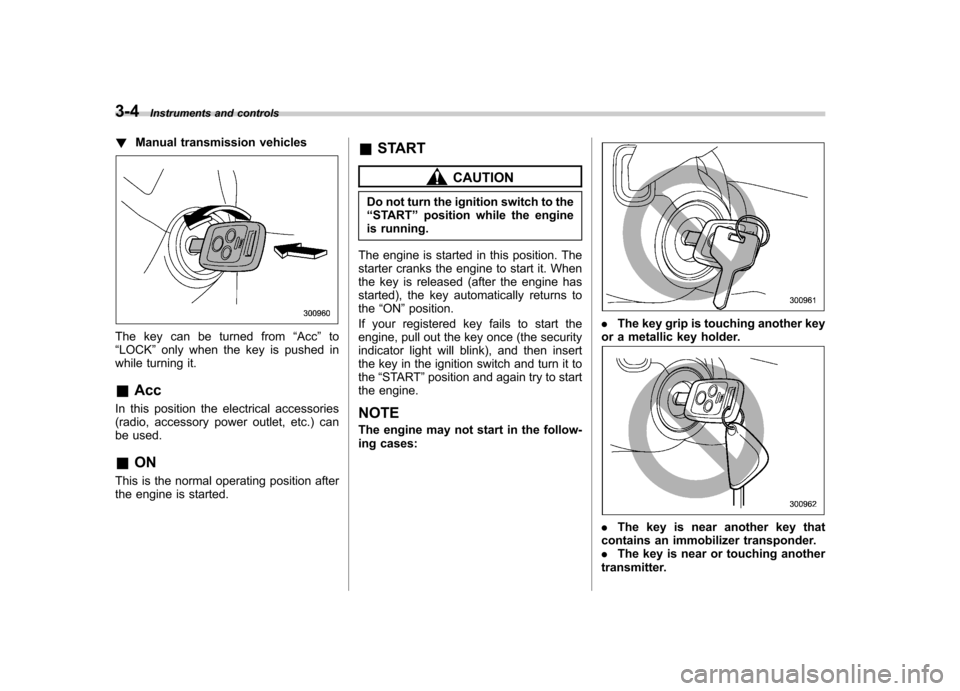
3-4Instruments and controls
!Manual transmission vehicles
The key can be turned from “Acc ”to
“ LOCK ”only when the key is pushed in
while turning it. & Acc
In this position the electrical accessories
(radio, accessory power outlet, etc.) can
be used. & ON
This is the normal operating position after
the engine is started. &
START
CAUTION
Do not turn the ignition switch to the “ START ”position while the engine
is running.
The engine is started in this position. The
starter cranks the engine to start it. When
the key is released (after the engine has
started), the key automatically returns to the “ON ”position.
If your registered key fails to start the
engine, pull out the key once (the security
indicator light will blink), and then insert
the key in the ignition switch and turn it tothe “START ”position and again try to start
the engine.
NOTE
The engine may not start in the follow-
ing cases:
. The key grip is touching another key
or a metallic key holder.
. The key is near another key that
contains an immobilizer transponder. . The key is near or touching another
transmitter.
Page 125 of 444
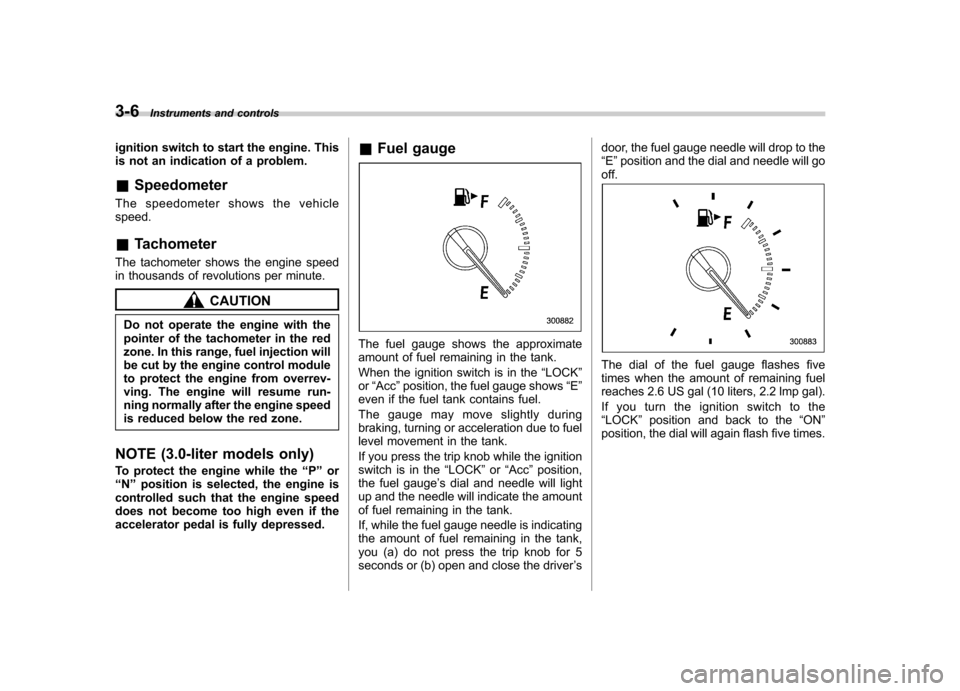
3-6Instruments and controls
ignition switch to start the engine. This
is not an indication of a problem. &Speedometer
The speedometer shows the vehicle speed. & Tachometer
The tachometer shows the engine speed
in thousands of revolutions per minute.
CAUTION
Do not operate the engine with the
pointer of the tachometer in the red
zone. In this range, fuel injection will
be cut by the engine control module
to protect the engine from overrev-
ving. The engine will resume run-
ning normally after the engine speed
is reduced below the red zone.
NOTE (3.0-liter models only)
To protect the engine while the “P ” or
“ N ” position is selected, the engine is
controlled such that the engine speed
does not become too high even if the
accelerator pedal is fully depressed. &
Fuel gauge
The fuel gauge shows the approximate
amount of fuel remaining in the tank.
When the ignition switch is in the “LOCK ”
or “Acc ”position, the fuel gauge shows “E ”
even if the fuel tank contains fuel.
The gauge may move slightly during
braking, turning or acceleration due to fuel
level movement in the tank.
If you press the trip knob while the ignition
switch is in the “LOCK ”or “Acc ”position,
the fuel gauge ’s dial and needle will light
up and the needle will indicate the amount
of fuel remaining in the tank.
If, while the fuel gauge needle is indicating
the amount of fuel remaining in the tank,
you (a) do not press the trip knob for 5
seconds or (b) open and close the driver ’s door, the fuel gauge needle will drop to the“
E ”position and the dial and needle will go
off.
The dial of the fuel gauge flashes five
times when the amount of remaining fuel
reaches 2.6 US gal (10 liters, 2.2 lmp gal).
If you turn the ignition switch to the “ LOCK ”position and back to the “ON ”
position, the dial will again flash five times.
Page 126 of 444
NOTE
You will see the“”sign in the fuel
gauge.
This indicates that the fuel filler door
(lid) is located on the right side of thevehicle. !
Low fuel warning light1) Low fuel warning light
The low fuel warning light comes on when
the tank is nearly empty [Approximately
2.6 US gal (10 liters, 2.2 lmp gal)].
It only operates when the ignition switch is
in the “ON ”position.
NOTE
This light does not go out unless the
tank is replenished up to an internal
fuel quantity of approximately 4.0 US
gal (15 liters, 3.3 lmp gal).
CAUTION
Promptly put fuel in the tank when-
ever the low fuel warning light
comes on. Engine misfires as a
result of an empty tank could cause
damage to the engine.
& Temperature gauge
1) Normal operating range
The temperature gauge shows engine
coolant temperature when the ignition
switch is in the “ON ”position.
The coolant temperature will vary in
accordance with the outside temperature
and driving conditions. Instruments and controls
3-7
– CONTINUED –
Page 127 of 444
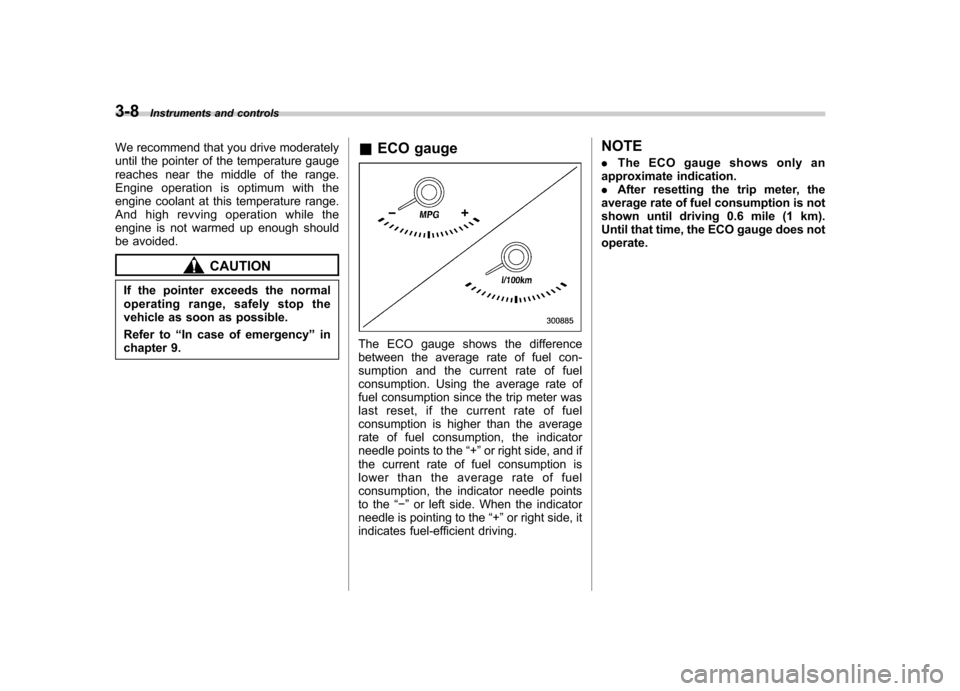
3-8Instruments and controls
We recommend that you drive moderately
until the pointer of the temperature gauge
reaches near the middle of the range.
Engine operation is optimum with the
engine coolant at this temperature range.
And high revving operation while the
engine is not warmed up enough should
be avoided.
CAUTION
If the pointer exceeds the normal
operating range, safely stop the
vehicle as soon as possible.
Refer to “In case of emergency ”in
chapter 9. &
ECO gauge
The ECO gauge shows the difference
between the average rate of fuel con-
sumption and the current rate of fuel
consumption. Using the average rate of
fuel consumption since the trip meter was
last reset, if the current rate of fuel
consumption is higher than the average
rate of fuel consumption, the indicator
needle points to the “+ ” or right side, and if
the current rate of fuel consumption is
lower than the average rate of fuel
consumption, the indicator needle points
to the “� ” or left side. When the indicator
needle is pointing to the “+ ” or right side, it
indicates fuel-efficient driving. NOTE .
The ECO gauge shows only an
approximate indication. . After resetting the trip meter, the
average rate of fuel consumption is not
shown until driving 0.6 mile (1 km).
Until that time, the ECO gauge does notoperate.
Page 131 of 444
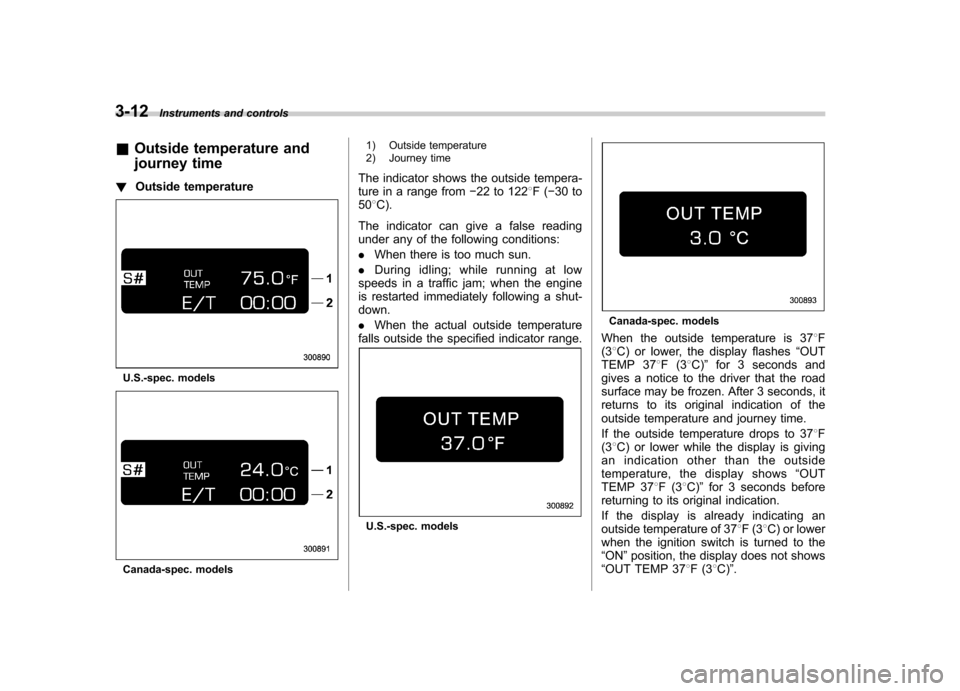
3-12Instruments and controls
& Outside temperature and
journey time
! Outside temperature
U.S.-spec. models
Canada-spec. models 1) Outside temperature
2) Journey time
The indicator shows the outside tempera-
ture in a range from �22 to 122 8F( �30 to
50 8C).
The indicator can give a false reading
under any of the following conditions: . When there is too much sun.
. During idling; while running at low
speeds in a traffic jam; when the engine
is restarted immediately following a shut-down. . When the actual outside temperature
falls outside the specified indicator range.
U.S.-spec. models
Canada-spec. models
When the outside temperature is 37 8F
(3 8C) or lower, the display flashes “OUT
TEMP 37 8F(3 8C) ”for 3 seconds and
gives a notice to the driver that the road
surface may be frozen. After 3 seconds, it
returns to its original indication of the
outside temperature and journey time.
If the outside temperature drops to 37 8F
(3 8C) or lower while the display is giving
an indication other than the outside
temperature, the display shows “OUT
TEMP 37 8F(3 8C) ”for 3 seconds before
returning to its original indication.
If the display is already indicating an
outside temperature of 37 8F(3 8C) or lower
when the ignition switch is turned to the“ ON ”position, the display does not shows
“ OUT TEMP 37 8F(3 8C) ”.
Page 132 of 444
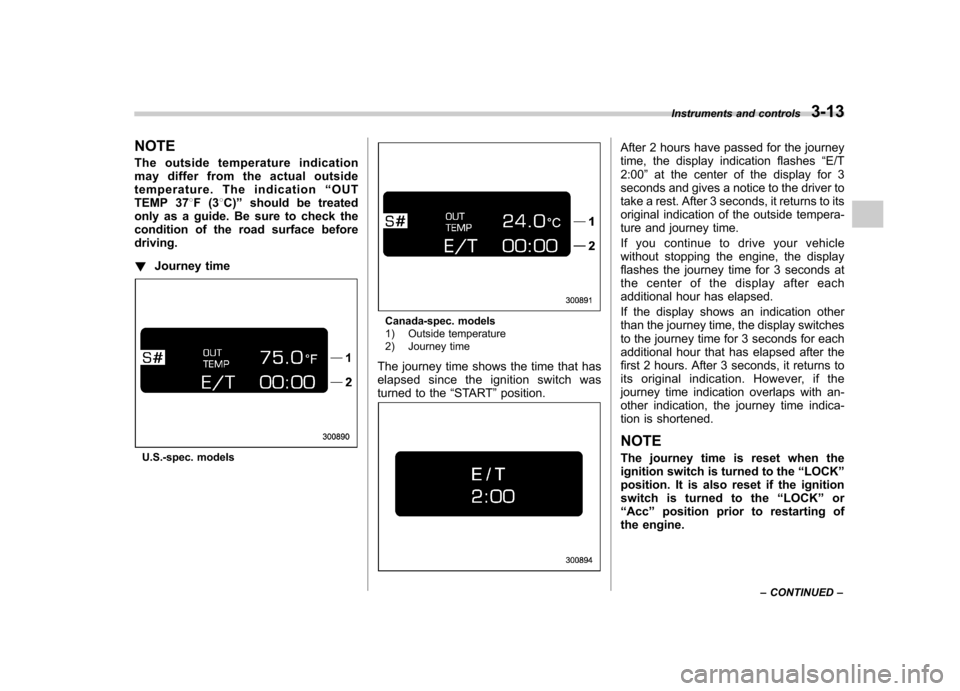
NOTE
The outside temperature indication
may differ from the actual outside
temperature. The indication“OUT
TEMP 37 8F(3 8C) ” should be treated
only as a guide. Be sure to check the
condition of the road surface beforedriving. ! Journey time
U.S.-spec. models
Canada-spec. models
1) Outside temperature
2) Journey time
The journey time shows the time that has
elapsed since the ignition switch was
turned to the “START ”position.
After 2 hours have passed for the journey
time, the display indication flashes “E/T
2:00 ”at the center of the display for 3
seconds and gives a notice to the driver to
take a rest. After 3 seconds, it returns to its
original indication of the outside tempera-
ture and journey time.
If you continue to drive your vehicle
without stopping the engine, the display
flashes the journey time for 3 seconds at
the center of the display after each
additional hour has elapsed.
If the display shows an indication other
than the journey time, the display switches
to the journey time for 3 seconds for each
additional hour that has elapsed after the
first 2 hours. After 3 seconds, it returns to
its original indication. However, if the
journey time indication overlaps with an-
other indication, the journey time indica-
tion is shortened.
NOTE
The journey time is reset when the
ignition switch is turned to the “LOCK ”
position. It is also reset if the ignition
switch is turned to the “LOCK ”or
“ Acc ”position prior to restarting of
the engine. Instruments and controls
3-13
– CONTINUED –
Page 141 of 444

3-22Instruments and controls
Warning messages Details
Door open warning
When any of the doors, the rear gate (Station wagon) or the trunk lid
(Sedan) is not fully closed, it is indicated by the corresponding part of the
door light.
Always make sure this warning message is out before you start to drive.
The display shows the interruptive warning message for 3 seconds.
Parking brake warning
This warning message comes on with the parking brake applied while the
ignition switch is in the“ON ”position. It goes out when the parking brake is
fully released.
The display shows the interruptive warning message for 3 seconds and
then returns to its original display. The interruptive warning message will be
displayed again after 20 seconds.
Run mode change system warning
This warning message indicates a malfunction of the “SI-DRIVE mode ”
change. If this warning message is shown on the display, contact your
nearest SUBARU dealer and have the SI-DRIVE mode system inspected.
The display shows the interruptive warning message for 3 seconds.
Engine coolant temperature warning
When the engine coolant temperature reaches 248 8F (120 8C), this warning
message is indicated. If this warning message is displayed, refer to the “ Engine overheating
”section in chapter 9 for details the necessary measures.
The display shows the interruptive warning message for 3 seconds.
Page 142 of 444
Driver’s information Details
Low temperature information
This message is displayed when the outside temperature is 378F(3 8C).
When this message appears on the display, be careful because the road
surface may be frozen. For details of this indication, refer to the “Outside
temperature and journey time ”section in this chapter.
Rest information
This message shows that the continuous driving time has reached 2 hours,
and a notice is displayed to take a rest. If you continue to drive the vehicle
without stopping the engine, the display is indicated after every hour that
has elapsed. For details of this indication, refer to the “
Outside temperature
and journey time ”section in this chapter. Instruments and controls
3-23